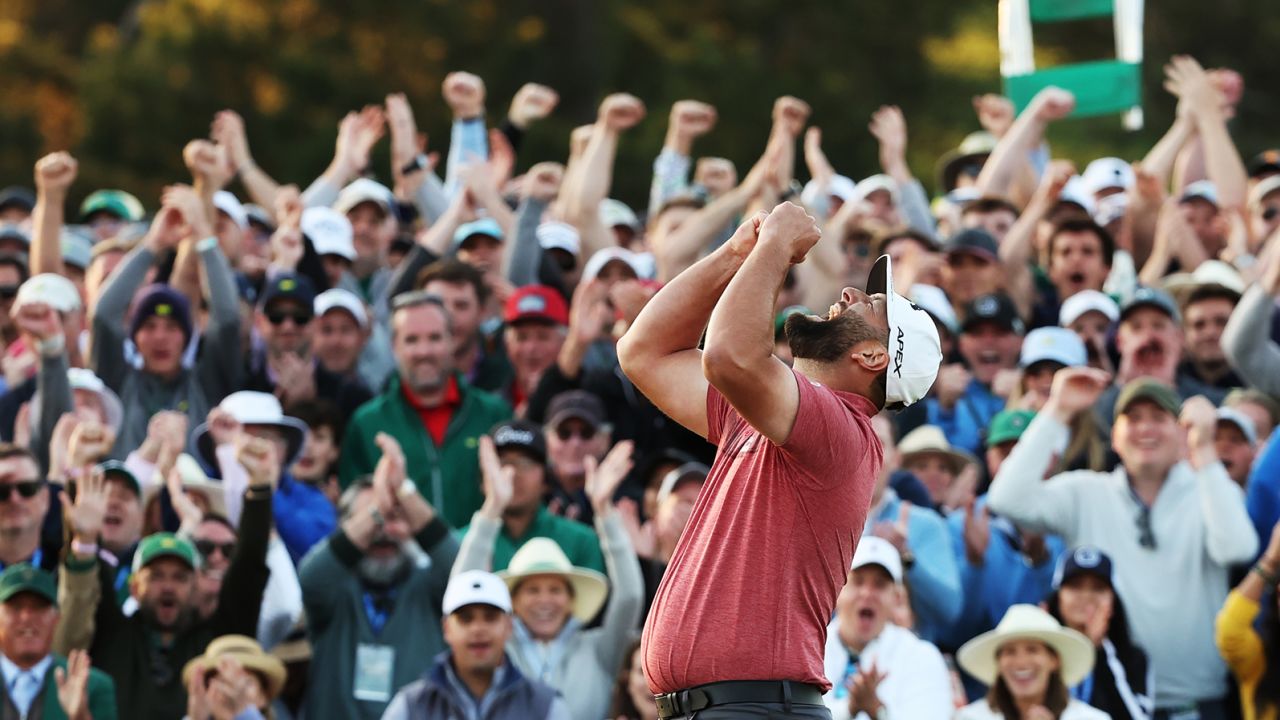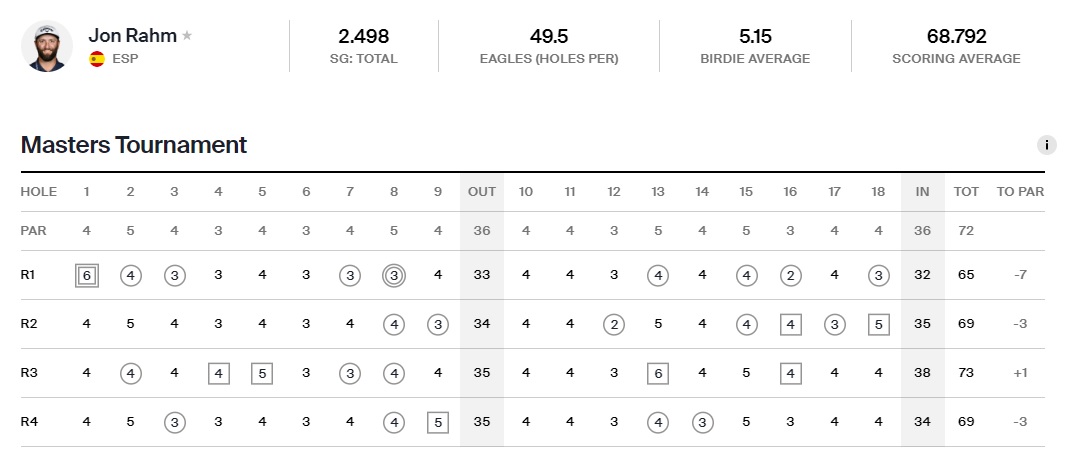
Jon Rahm four-putted his first hole of the tournament, got the bad end of the draw, played through weather that required a tricky conjugation of the word squeegee, and had ample justification to look to the sky and scream (bilingually) at the golf gods. But Rahm, who shot 69 to come from behind and win the 87th Masters Tournament by four over Brooks Koepka (75) and Phil Mickelson (65), had an inner-game ally, someone who simply wouldn’t let him go to the dark side. A better angel who was in Rahm’s ear come a spasm of hellish putting or the high water of unrelenting rain – all the way until he wiped away tears walking to the 18th green, saved par, and hugged his caddie, wife and two young children. “If you’re going to make a double or four-putt or anything,” this ally said Thursday, after Rahm had collected himself to shoot 65, “it might as well be the first hole.” When play was called Saturday with 11-plus holes remaining in Rahm’s third round, and he trailed Koepka by two, Professor Positive said: “A lot of holes. But feeling good, feeling strong, and keep it going.” And after Rahm finished his third round Sunday morning, still two back: “Feeling good, playing good, swinging well …” This mental-game Svengali in Rahm’s corner was, of course, Rahm himself, which is to say that this Masters, like life, was in how you looked at it. Half of it was a discombobulated, disjointed mess, with rounds no longer ending when days did, making it hard to establish a narrative. Rahm didn’t dwell on that half. He began the final round two strokes behind Koepka but played the first eight holes in 2 under (birdies at the par-4 third and par-5 eighth) while Koepka played them in 2 over (bogeys at the par-3 fourth and sixth) to seize control of the tournament. 
“What is going on on the outside is not always a reflection of the inside,” Rahm said. “I was calm. I never got frustrated. I never really got – felt like anything was out of control. But obviously you're nervous, right. There’s tension out there.”
He especially didn’t like making bogey on the ninth hole, he added, with Mickelson and Jordan Spieth (66, T4, five back) posting a flurry of birdies up ahead. But it didn’t matter in the end. It was Rahm’s sixth win in his last 12 starts on the PGA TOUR or DP World Tour, and with his 11th PGA TOUR title and second major victory – the 2021 U.S. Open was his other – he returns to world No. 1. His patience, the knowledge that his stuff will win out over four rounds, has become his 15th club, so much so that he came from seven back (to Collin Morikawa) at the Sentry Tournament of Champions in January, the high point of never-say-die-ism on his growing list of comebacks. That four-shot deficit to Koepka as they resumed the third round Sunday? Please. Rahm rolled out of bed and rolled in his 9-foot birdie putt at the seventh hole while Koepka missed his par save from 11 feet, and the margin was two again. Each signed for a 73; still a two-shot deficit. Two shots? That’s nothing, especially not at Augusta National. The final round wasn’t particularly close, Koepka failing to make a birdie until 13 when it was too little, too late. Rahm covered it with a birdie of his own and was three up with five to play. Although he has become the very last person a leader wants to see in his rear-view mirror, there was a time when Rahm, 28, could be his own worst enemy. Part of that was immaturity. “I mean, I went from being in college to being top 10 in the world in nine months from 2016 to 2017,” he said earlier this season. Indeed, he tied for third in his professional debut in June 2016 at the Quicken Loans National at Congressional, got his first win in January 2017 at the Farmers Insurance Open, and finished T2 at the Charles Schwab Challenge in May of that year. Those results, plus a bunch of other top-10s, sent him from Arizona State Sun Devil to ninth in the world. “My next year wasn’t as good; the period of adaptation was too quick,” he said. “You can’t prep anybody for that, being in college, when nobody knows you exist, to being a star.” To watch him pull away from Koepka on the back nine, when Rahm birdied 13 and 14 to leave no doubt, was to marvel at how quickly he figured it out. Comfortable in his own skin, he has built a mental toughness to match his fearsome skillset. Like Scottie Scheffler last year, Rahm came into this week at FedExCup No. 1 and with three wins on the season. In winning his fourth, he added his name to a list of Spanish Masters winners that includes Seve Ballesteros (1980, ’83), José María Olazábal (1994, ’99) and Sergio Garcia (2017). Ballesteros, who died in 2011, would have celebrated his 66th birthday Sunday. Neither that bit of synergy nor anything else distracted Rahm, although it could have. “I kept hearing, ‘Seve! Seve! Seve! Do it for Seve!’” Rahm said. “I heard that the entire back nine. That might have been the hardest thing to control today, is the emotion of knowing what it could be if I were to win; that might have been the hardest thing.” The cold, wet weather made for a long, unforgiving course, sending the premium ball-strikers, especially those who could power their way through the elements, to the front of the line. “Most of the battle out there is just trying to keep yourself in some kind of head space that you can function,” long-hitting Cameron Young said after enduring a third-round 75.
By the time the final round arrived, the sun shone, and temperatures hit the low 60s. None of the scores reached that exalted number – 65 was the best anyone could do – and though no data is available, Rahm’s blood pressure was somewhere in the range of cool over calculated. He’s got the long game, short game, and now the mental game. For anyone with designs on winning one of the big ones in the foreseeable future, Jon Rahm is the full nightmare. |